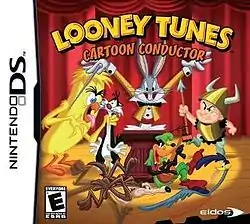Looney Tunes: Cartoon Conductor
Looney Tunes: Cartoon Conductor (known as Looney Tunes: Cartoon Concerto in Europe and Australia) is a Nintendo DS game developed by Amaze Entertainment and published by Eidos Interactive.
 | |
| Developer(s) | Amaze Entertainment |
|---|---|
| Publisher(s) | Eidos Interactive |
| Platform(s) | Nintendo DS |
| Release | |
Plot
The game starts with Bugs Bunny standing in front of a stage. Bugs explains that the Tasmanian Devil destroyed the classical music in some old Looney Tunes and Merrie Melodies cartoons, so it's up to the player to conduct a new orchestra to refill the Looney Tunes cartoon background music. Bugs then will teach the player about how to conduct the orchestra.
Gameplay
Players must conduct an orchestra to perform at a classic Looney Tunes cartoon. To start the orchestra, players must tap three times on the touch screen, like a real conductor. To make the orchestra perform perfectly, players must tap or drag the notes at the right times; if not the performance meter will go down. If the performance meter depletes completely, the orchestra will be canceled and the game will end. There are four difficulties: Apprentice (easy), Conductor (normal), Maestro (hard), and a fourth, unlockable mode and the hardest one: Looney. This mode is about as hard as Maestro mode, but unlike the other difficulties, the player must play through the intervals instead of just watching them.
Each time the player taps or drags a note, the player will gain a varying number of points. The number of points depends on the player's accuracy. There are four accuracy levels in the game: Gold, Silver, Normal, and Miss. The score level, scores, and combos also affects the performance meter, the audience, the cartoon, and the musical grade. There are five musical grades: S+, S, A, B and C. The musical grade can be guessed by the amount of applause when the cartoon ends.
Track list
| Melody title | Composer |
|---|---|
| "Orpheus in the underworld: Can-Can" | Jacques Offenbach |
| "Flight of the Bumblebee" | Nicolay Rimsky-Korsakov |
| "Ride of the Valkyries" | Richard Wagner |
| "The Planets: Mars, The Bringer of War" | Gustav Holst |
| "Symphony no. 5" | Ludwig van Beethoven |
| "Hungarian Rhapsody no. 2" | Franz Liszt |
| "Carmen: Torreador March" | Georges Bizet |
| "Mexican hat dance" | Jesús González Rubio |
| "Toccata and fugue in D minor" | Johann Sebastian Bach |
| "The Barber of Seville" | Gioachino Rossini |
| "William Tell Overture" | Gioachino Rossini |
| "Concerto for 2 horns" | Georg Philipp Telemann |
| "The Nutcracker: Dance of the Reed Flutes" (used as a main theme) | Pyotr Iliych Tchaikovsky |
Reception
| Aggregator | Score |
|---|---|
| Metacritic | 67/100[1] |
| Publication | Score |
|---|---|
| 1Up.com | B[2] |
| Destructoid | 2.5/10[3] |
| GamesMaster | 73%[4] |
| GameSpot | 6.5/10[5] |
| GamesTM | 7/10[6] |
| GameZone | 7.8/10[7] |
| IGN | 6.8/10[8] |
| NGamer | 69%[9] |
| Nintendo Power | 6.5/10[10] |
| ONM | 68%[11] |
Cartoon Conductor received "average" reviews according to the review aggregation website Metacritic.[1]
References
- "Looney Tunes: Cartoon Conductor Critic Reviews for DS". Metacritic. Retrieved 2014-05-19.
- Hayward, Andrew (2008-06-17). "Looney Tunes: Cartoon Conductor Review". 1UP.com. Archived from the original on 2016-03-04. Retrieved 2014-05-19.
- 8BitBrian (2008-06-28). "Destructoid review: Looney Tunes: Cartoon Conductor". Destructoid. Retrieved 2014-05-19.
- "Looney Tunes: Cartoon Concerto". GamesMaster: 83. August 2008.
- Massimilla, Bethany (2008-07-28). "Looney Tunes: Cartoon Conductor Review". GameSpot. Retrieved 2014-05-19.
- "Looney Tunes: Cartoon Concerto". GamesTM: 109. August 2008.
- Woodward, Stephen (2008-07-08). "Looney Tunes: Cartoon Conductor - NDS - Review". GameZone. Archived from the original on 2008-10-14. Retrieved 2014-05-19.
- Harris, Craig (2008-08-12). "Looney Tunes Cartoon Conductor Review". IGN. Retrieved 2014-05-19.
- "Looney Tunes: Cartoon Concerto". Nintendo Gamer: 68. August 2008.
- "Looney Tunes: Cartoon Conductor". Nintendo Power. 230: 90. July 2008.
- "Looney Tunes: Cartoon Concerto". Official Nintendo Magazine: 99. September 2008.